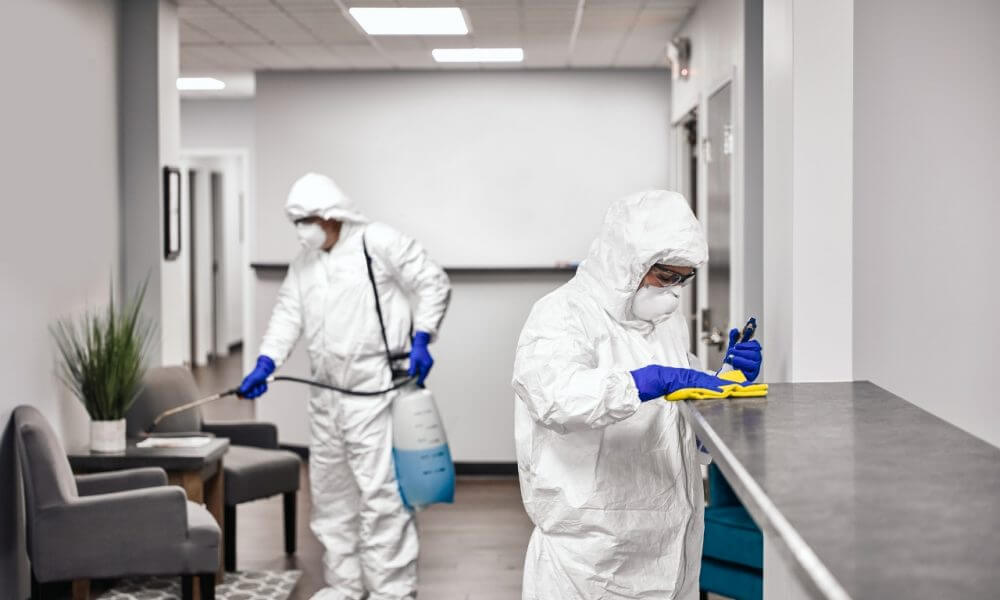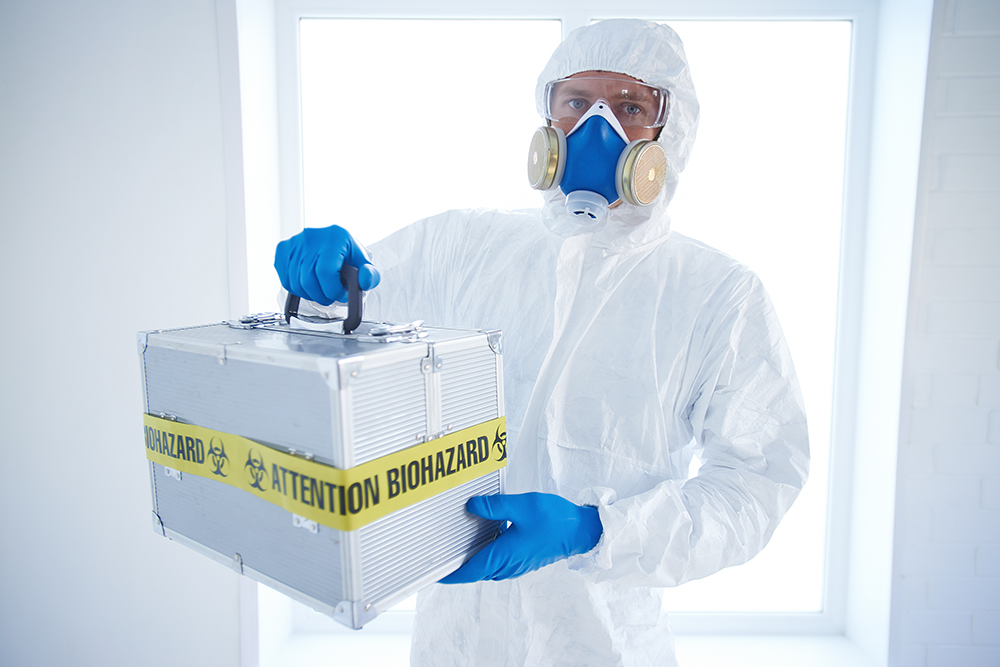Mold Remediation Providers: Safeguarding Your Property from Mold And Mildew Damage
Mold Remediation Providers: Safeguarding Your Property from Mold And Mildew Damage
Blog Article
Expert Biohazard Cleaning and Decontamination for Blood, Bodily Fluids, and Hazardous Materials
The possible health and wellness dangers linked with direct exposure to biohazards highlight the critical demand for precise handling and complete cleaning. As we browse the complex landscape of biohazard cleaning, recognizing the subtleties of laws, compliance, and the customized tools at play ends up being important in guaranteeing a secure and comprehensive purification process.
Wellness Risks of Biohazard Exposure
Direct exposure to biohazards positions significant wellness threats that can cause severe effects for areas and individuals alike. Biohazards encompass a wide variety of organic materials, consisting of blood, physical fluids, mold and mildew, microorganisms, viruses, and other potentially contagious products. When individuals enter into call with these biohazards, whether with mishaps, improper handling, or environmental exposure, they face the danger of contracting serious illnesses or conditions.
One of the primary health risks connected with biohazard direct exposure is the transmission of transmittable illness. Bloodborne pathogens such as HIV, liver disease B and C, and numerous microorganisms can be existing in biohazardous products, posing a straight threat to human wellness. Breathing in airborne biohazards like mold and mildew spores or entering into call with contaminated surface areas can also lead to breathing issues, allergic reactions, and other negative health and wellness effects.
Furthermore, biohazard direct exposure can have lasting health and wellness effects, with some illness showing up years after the preliminary call (Blood Cleanup). As a result, it is crucial to prioritize appropriate biohazard cleansing and purification to mitigate these health risks and guarantee the security of areas and individuals

Specialized Training for Biohazard Cleaning
When it involves taking care of biohazard cleanup efficiently and securely, specialized training plays a fundamental duty in making sure appropriate decontamination procedures are complied with. Biohazard cleanup needs details knowledge and abilities to successfully mitigate risks connected with bloodborne virus, bodily fluids, and unsafe products. Experts learnt biohazard cleanup go through rigorous direction on just how to securely handle, get rid of, and get rid of biohazardous materials to prevent contamination and exposure.
Specialized training for biohazard clean-up covers a variety of important subjects, including appropriate personal protective tools (PPE) use, bloodborne pathogen awareness, purification strategies, and contaminated materials disposal methods. People educated in biohazard cleaning are furnished with the essential proficiency to examine contamination levels, recognize potential dangers, and implement suitable cleanup treatments in compliance with regulatory requirements.
Continual training and education are vital in the field of biohazard cleaning to remain updated on the current purification technologies, safety procedures, and guidelines. By purchasing specialized training, biohazard clean-up specialists can effectively respond to emergency situation clean-up scenarios and safeguard both public wellness and the setting.
Value of Correct Purification Strategies
Utilizing appropriate purification methods is essential in biohazard cleanup to efficiently remove unsafe products and reduce wellness risks. Efficient decontamination not only makes sure the elimination of noticeable traces of blood, physical fluids, and various other biohazards however likewise targets unnoticeable microorganisms that might pose serious health dangers otherwise correctly eliminated. By following stringent purification procedures, trained experts can dramatically lower the threat of exposure to unsafe bacteria, viruses, and bacteria that could result in infections or conditions.
Correct decontamination techniques involve making use of specialized tools and disinfectants that are especially developed to reduce the effects of biohazards efficiently. Thorough cleaning and sanitation of infected locations are essential to avoid the spread of virus and make certain a risk-free atmosphere for residents. Additionally, the proper disposal of biohazardous waste following purification procedures is important in protecting against contamination of various other surface areas or people.

Devices and Tools for Safe Cleanup
The appropriate devices and tools play a vital function in ensuring the risk-free and effective cleanup of biohazardous products. When dealing with blood, physical fluids, or dangerous materials, biohazard cleaning specialists rely on specialized equipment to reduce exposure threats and completely decontaminate the damaged location. Individual protective tools (PPE) crime scene cleanup companies near me such as gloves, goggles, coveralls, and masks are important to secure versus direct call with possibly transmittable products. In addition, biohazard cleansing sets including anti-bacterials, absorbing materials, and biohazard bags are utilized to safely get rid of and include of contaminated items. Blood Cleanup.
Advanced cleaning devices like hospital-grade anti-bacterials, HEPA-filtered vacuum cleaners, and fogging machines are utilized to sanitize surfaces and remove biohazards effectively. Specialized tools such as sharps containers and biohazard waste disposal containers are made use of to safely handle sharp things and biohazardous waste products. By making use of the ideal tools and devices, biohazard cleansing experts can make certain a comprehensive cleanup process that focuses on safety and security and reduces wellness risks for both employees and occupants of the afflicted space.
Laws and Compliance in Biohazard Cleansing
Proper adherence to policies and conformity criteria is critical in biohazard cleansing to make sure the security of both workers and the atmosphere. Government agencies such as OSHA (Occupational Security and Wellness Administration) and the EPA (Environmental Security Agency) have actually developed specific guidelines for find here biohazard clean-up procedures to lessen health risks and ecological contamination. These laws cover a variety of aspects consisting of the handling, transport, and disposal of biohazardous materials, in addition to the necessary training and protective equipment needed for employees associated with the cleanup process.
Biohazard cleansing companies must stay updated with these regulations to ensure that their procedures fulfill the needed safety and security requirements. Failing to abide by these regulations can cause extreme effects, consisting of penalties, lawsuit, and endangering the health of individuals and the atmosphere. By following strict regulations and compliance steps, biohazard cleaning firms can efficiently reduce risks and make certain a safe and detailed cleanup procedure for all events involved.
Conclusion
To conclude, biohazard cleansing and decontamination need specific training, proper methods, and adherence to laws. Exposure to blood, physical fluids, and unsafe products poses substantial wellness risks, making it vital to use the right equipment and devices for secure cleaning. By complying with rigorous protocols and standards, professionals can properly minimize the threats connected with biohazard direct exposure and make certain the safety and security of both themselves and read others.
As we navigate the intricate landscape of biohazard cleaning, recognizing the subtleties of regulations, compliance, and the customized equipment at play comes to be essential in making sure a secure and comprehensive purification procedure. (Blood Cleanup)
When it comes to managing biohazard cleaning effectively and safely, specialized training plays a basic role in making certain correct purification treatments are followed.Utilizing correct decontamination techniques is essential in biohazard cleaning to efficiently get rid of unsafe products and decrease wellness dangers. Additionally, biohazard cleaning kits including anti-bacterials, absorptive materials, and biohazard bags are used to securely consist of and dispose of polluted products.
Federal government companies such as OSHA (Occupational Security and Health Administration) and the EPA (Environmental Defense Agency) have developed specific standards for biohazard cleaning procedures to minimize health dangers and ecological contamination.
Report this page